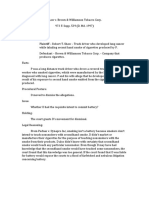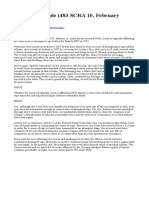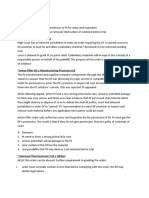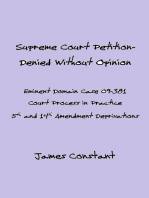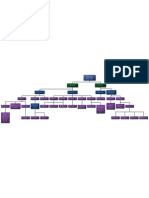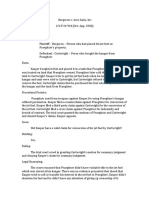Bradley v. American Smelting and Refining Co
Bradley v. American Smelting and Refining Co
Uploaded by
ankurpatel96706Copyright:
Available Formats
Bradley v. American Smelting and Refining Co
Bradley v. American Smelting and Refining Co
Uploaded by
ankurpatel96706Copyright
Available Formats
Share this document
Did you find this document useful?
Is this content inappropriate?
Copyright:
Available Formats
Bradley v. American Smelting and Refining Co
Bradley v. American Smelting and Refining Co
Uploaded by
ankurpatel96706Copyright:
Available Formats
Bradley v. American Smelting and Refining Co.
709 P.2d 782 (Wash. 1984)
Parties:
Plaintiff – Bradley – Property owners who had microscopic particles
on it.
Defendant – American Smelting and Refining Co. – Company that
smelts copper.
Facts:
Part of D’s smelting process, D emits into the atmosphere gasses and
particulate matter. Some particulate emissions of cadmium and arsenic from D’s
plant have been continually deposited on P’s land. D had been aware of this since it
took over the plant in 1905. D was also aware that sometimes the wind cases the
particulate matter to blow over to the island on which P’s property is located.
Procedural Posture:
Case was initially started in state court but was removed to federal district
court. P moved for summary judgment on the issue of liability for the trespass.
Issue:
Did the D have the requisite intent to commit intentional trespass as a matter
of law?
Does an intentional deposit of microscopic particles undetectable by the
human senses upon a person’s property give rise to a cause of action for trespassory
invasion of the person’s right to exclusive possession of property as well as a claim
of nuisance?
Does the cause of action for trespassory invasion require proof of actual
damages?
Holding:
The court dismisses P’s claim because P failed to show actual and substantial
damages from the trespass.
Legal Reasoning:
Legal Reasoning – Issue 1
The court found that D had the requisite intent needed to commit intentional
trespass as a matter of law. The court found from the Second Restatement of Torts
on 15b:
If the actor knows that the consequences are certain or substantially certain
to result from this act and still goes ahead the law treats him as if he had in
fact desired to produce the result.
The court reasoned that the D acted on his own volition and had to have known with
substantial certainty that the law of gravity would put the particulate matter on
someone’s property somewhere.
Legal Reasoning – Issue 2
The court reasoned that the trespassory invasion doesn’t have to be “direct”
or an “object, or something tangible”. The court said that weather assures that
pollutants deposited in one place will end up somewhere else, even though the actor
isn’t watching it. Also, the trespass doesn’t have to be a tangible object because the
court held in Martin v. Reynolds Metals that gaseous and particulate matter
constituted a trespass.
In order to recover for trespass of land, a plaintiff must show
1. An invasion affecting an interest in the exclusive possession of his
property.
2. An intentional doing of the act which results in the invasion
3. Reasonable foreseeability that the act done could result in an invasion
of P’s possessory interest
4. Substantial damages to the res.
Legal Reasoning – Issue 3
The court dismissed his claim because P failed to show actual and substantial
damages.
You might also like
- Missouri Child Custody FormDocument46 pagesMissouri Child Custody Formitargeting0% (1)
- MBE I - ActualDocument77 pagesMBE I - ActualCleve Collado67% (9)
- Shaw v. Brown & Williamson Tobacco CorpDocument1 pageShaw v. Brown & Williamson Tobacco Corpankurpatel96706No ratings yet
- Alpajora v. CalayanDocument3 pagesAlpajora v. CalayanAnonymous Sh9WMvlNo ratings yet
- Civ Pro OutlineDocument32 pagesCiv Pro OutlineNicole PocciaNo ratings yet
- IndictmentDocument2 pagesIndictmentCBS Austin WebteamNo ratings yet
- English Tort Law CasesDocument58 pagesEnglish Tort Law CasesSha HazannahNo ratings yet
- City MotionDocument7 pagesCity MotionJohn DodgeNo ratings yet
- Specific Performance NotesDocument12 pagesSpecific Performance NotesElle Soleil100% (7)
- Teichmiller v. Rogers Memorial Hospital INCDocument2 pagesTeichmiller v. Rogers Memorial Hospital INCankurpatel96706No ratings yet
- Attorney in Fact SubstitutionDocument1 pageAttorney in Fact SubstitutionGio Trieste86% (7)
- Tom Sullivan Shore Power Lawsuit Against MSC Cruises & Miami-Dade CountyDocument160 pagesTom Sullivan Shore Power Lawsuit Against MSC Cruises & Miami-Dade CountyMiami HeraldNo ratings yet
- Baleros VS People DigestDocument1 pageBaleros VS People DigestSam Maulana100% (1)
- Tort - First PDFDocument4 pagesTort - First PDFArthur FleckNo ratings yet
- Injunction - O29Document4 pagesInjunction - O29alislegalfjNo ratings yet
- 8 - Lecture On TortsDocument25 pages8 - Lecture On TortsZubayer AhmmedNo ratings yet
- Anton Piller InjunctionsDocument23 pagesAnton Piller Injunctionsflexton campbellNo ratings yet
- Evidence Sept 19Document18 pagesEvidence Sept 19JV DeeNo ratings yet
- Property OutlineDocument62 pagesProperty OutlineAílíse DelaneyNo ratings yet
- Civil Procedure OutlineDocument60 pagesCivil Procedure OutlineKayte McClintockNo ratings yet
- Domalsin v. Spouses ValencianoDocument15 pagesDomalsin v. Spouses ValencianoAiyla AnonasNo ratings yet
- Civil Procedure I - OutlineDocument48 pagesCivil Procedure I - Outlinemikean23No ratings yet
- Property OutlineDocument30 pagesProperty Outlinejenl_7100% (2)
- Tutorial 3 Civil Law (AS)Document2 pagesTutorial 3 Civil Law (AS)Anis RazwanNo ratings yet
- Bank Brussels Lambert v. Fiddler Gonzalez & Rodriguez, 305 F.3d 120, 2d Cir. (2002)Document12 pagesBank Brussels Lambert v. Fiddler Gonzalez & Rodriguez, 305 F.3d 120, 2d Cir. (2002)Scribd Government DocsNo ratings yet
- Anton Piller Order: Halsbury's Laws of MalaysiaDocument5 pagesAnton Piller Order: Halsbury's Laws of MalaysiatiaNo ratings yet
- United States Court of Appeals, First CircuitDocument7 pagesUnited States Court of Appeals, First CircuitScribd Government DocsNo ratings yet
- Almeda V RepublicDocument2 pagesAlmeda V RepublicClyde KitongNo ratings yet
- Ramos Vs DizonDocument2 pagesRamos Vs DizonLaika CorralNo ratings yet
- Intention V MotiveDocument3 pagesIntention V MotiveAnonymous z2FpUymFQNo ratings yet
- Theft Burglary - Updated!Document6 pagesTheft Burglary - Updated!Sher KhanNo ratings yet
- Civil Procedure (Old)Document25 pagesCivil Procedure (Old)Mark CianciulliNo ratings yet
- Pre TrialDocument6 pagesPre Trialerickson romeroNo ratings yet
- Legal Aptitude Practise Ex 2Document14 pagesLegal Aptitude Practise Ex 2rudraniNo ratings yet
- Class Outline - Interference With Goods and Trespass To LandDocument10 pagesClass Outline - Interference With Goods and Trespass To LandAyman KhanNo ratings yet
- Ge Board 2024 Eval Exam 1 QuestionsDocument6 pagesGe Board 2024 Eval Exam 1 QuestionsHannah Mae GuimbonganNo ratings yet
- Citadel Corporation v. Puerto Rico Highway Authority, 695 F.2d 31, 1st Cir. (1983)Document5 pagesCitadel Corporation v. Puerto Rico Highway Authority, 695 F.2d 31, 1st Cir. (1983)Scribd Government DocsNo ratings yet
- United States v. Reginald Max Goldsmith, 978 F.2d 643, 11th Cir. (1992)Document6 pagesUnited States v. Reginald Max Goldsmith, 978 F.2d 643, 11th Cir. (1992)Scribd Government DocsNo ratings yet
- Case Laws (Torts)Document13 pagesCase Laws (Torts)ranjanharshit052No ratings yet
- Strict Liability and Absolute LiabilityDocument45 pagesStrict Liability and Absolute LiabilityKRITI mNo ratings yet
- Criminal Procedure OutlineDocument36 pagesCriminal Procedure OutlineTravis Dunsmoor100% (1)
- CasesDocument13 pagesCasesKwaku Adom OseiNo ratings yet
- Torts - LatinDocument29 pagesTorts - LatinSawyer LikeNo ratings yet
- Torts and Damages Case Digest 1-20 CasesDocument28 pagesTorts and Damages Case Digest 1-20 CasesMAL - Sushane BituinNo ratings yet
- Civpro Stack Fall09 OutlineDocument36 pagesCivpro Stack Fall09 OutlineRyan HilerNo ratings yet
- Injuction CasesDocument5 pagesInjuction CasesLatoya Toya EbanksNo ratings yet
- Liuxia Wong vs. Hard Drive Productions: Defendant Motion To DismissDocument8 pagesLiuxia Wong vs. Hard Drive Productions: Defendant Motion To DismissExtortionLetterInfo.comNo ratings yet
- 05 Disini v. SandiganbayanDocument2 pages05 Disini v. SandiganbayanHenri VasquezNo ratings yet
- Civ Pro OutlineDocument8 pagesCiv Pro Outlinedurangokid22No ratings yet
- Torts OutlineDocument34 pagesTorts Outlinebobloblaw55No ratings yet
- Civil Procedure Unit 1: Burden of PleadingsDocument7 pagesCivil Procedure Unit 1: Burden of PleadingsbluwingznthingzNo ratings yet
- Constantino Vs ConstantinoDocument2 pagesConstantino Vs ConstantinooabeljeanmoniqueNo ratings yet
- Transcript, Sheetz v. County of El Dorado, No. 22-1074 (U.S. Jan. 9, 2024)Document108 pagesTranscript, Sheetz v. County of El Dorado, No. 22-1074 (U.S. Jan. 9, 2024)RHTNo ratings yet
- Porn Magazine Lawsuit OrderDocument8 pagesPorn Magazine Lawsuit OrderLaw&CrimeNo ratings yet
- Torts - Group 5Document20 pagesTorts - Group 5mweluaNo ratings yet
- Goodland Company, Inc. Vs Co and ChanDocument2 pagesGoodland Company, Inc. Vs Co and ChanJay EmNo ratings yet
- Tutorial Questions LIA4013 2020-2021Document8 pagesTutorial Questions LIA4013 2020-2021sofea malayaNo ratings yet
- Michael Snow v. Directv, Inc., 450 F.3d 1314, 11th Cir. (2006)Document10 pagesMichael Snow v. Directv, Inc., 450 F.3d 1314, 11th Cir. (2006)Scribd Government DocsNo ratings yet
- Crim JceDocument12 pagesCrim Jceaniketmookerjee.advNo ratings yet
- In Re: Anne L. O'DOwD Anne L. O'DOwD v. Howard C. Trueger David B. Biunno Vincent D. Commisa Marisa A. Taormina Biunno, Commisa and Taormina, P.C, 233 F.3d 197, 3rd Cir. (2000)Document9 pagesIn Re: Anne L. O'DOwD Anne L. O'DOwD v. Howard C. Trueger David B. Biunno Vincent D. Commisa Marisa A. Taormina Biunno, Commisa and Taormina, P.C, 233 F.3d 197, 3rd Cir. (2000)Scribd Government DocsNo ratings yet
- Strict LiabilityDocument6 pagesStrict Liabilitykkamau7No ratings yet
- United States v. One Parcel of Real Property, Etc., Humberto and Idacira Rua, 921 F.2d 370, 1st Cir. (1990)Document11 pagesUnited States v. One Parcel of Real Property, Etc., Humberto and Idacira Rua, 921 F.2d 370, 1st Cir. (1990)Scribd Government DocsNo ratings yet
- Lecture 8A - The Law of TortDocument65 pagesLecture 8A - The Law of Torthi_monestyNo ratings yet
- The Holy See vs. G.R. No. 101949 Facts:: The Hon. Eriberto U. Rosario, Jr. and Starbright Sales Enterprises, Inc.Document7 pagesThe Holy See vs. G.R. No. 101949 Facts:: The Hon. Eriberto U. Rosario, Jr. and Starbright Sales Enterprises, Inc.LJ W SantosNo ratings yet
- Property Nov AdditionalDocument7 pagesProperty Nov Additionalトレンティーノ アップルNo ratings yet
- California Supreme Court Petition: S173448 – Denied Without OpinionFrom EverandCalifornia Supreme Court Petition: S173448 – Denied Without OpinionRating: 4 out of 5 stars4/5 (1)
- Supreme Court Eminent Domain Case 09-381 Denied Without OpinionFrom EverandSupreme Court Eminent Domain Case 09-381 Denied Without OpinionNo ratings yet
- Contracts FlowchartDocument1 pageContracts Flowchartankurpatel96706No ratings yet
- Wagner v. StateDocument2 pagesWagner v. Stateankurpatel96706No ratings yet
- Fisher v. Carrousel Motor Hotel IncDocument2 pagesFisher v. Carrousel Motor Hotel Incankurpatel96706No ratings yet
- Holloway v. Wachovia Bank & Trust CoDocument2 pagesHolloway v. Wachovia Bank & Trust Coankurpatel96706No ratings yet
- Garratt v. DaileyDocument1 pageGarratt v. Daileyankurpatel96706No ratings yet
- Figueiredo-Torres v. NickelDocument2 pagesFigueiredo-Torres v. Nickelankurpatel96706No ratings yet
- Caldor v. BowdenDocument2 pagesCaldor v. Bowdenankurpatel96706No ratings yet
- Bergeron v. Aero Sales IncDocument2 pagesBergeron v. Aero Sales Incankurpatel96706No ratings yet
- Baska v. ScherzerDocument1 pageBaska v. Scherzerankurpatel967060% (1)
- Amphitheaters Inc v. Portland MeadowsDocument1 pageAmphitheaters Inc v. Portland Meadowsankurpatel96706No ratings yet
- Mijares v. RanadaDocument5 pagesMijares v. RanadaYodh Jamin OngNo ratings yet
- Accountancy in AdvocacyDocument15 pagesAccountancy in AdvocacytripathichotuNo ratings yet
- ClintDocument3 pagesClintMary Jane SaladinoNo ratings yet
- Subpoena From Assemblywoman Maggie Carlton To The Gaming Control BoardDocument7 pagesSubpoena From Assemblywoman Maggie Carlton To The Gaming Control BoardMegan MesserlyNo ratings yet
- Administrative Law NotesDocument25 pagesAdministrative Law NotesEly Velasco100% (2)
- Code and Standards: of Professional ConductDocument10 pagesCode and Standards: of Professional ConductNirjhor ShikderNo ratings yet
- Bryant v. Sagamore Insurance Co., 10th Cir. (2015)Document13 pagesBryant v. Sagamore Insurance Co., 10th Cir. (2015)Scribd Government DocsNo ratings yet
- Sample Assessment Answers 8th GradeDocument3 pagesSample Assessment Answers 8th Gradeapi-383148273No ratings yet
- NSTP 3Document2 pagesNSTP 3Angelica VidaNo ratings yet
- Grajales Romero v. American Airlines, 194 F.3d 288, 1st Cir. (1999)Document15 pagesGrajales Romero v. American Airlines, 194 F.3d 288, 1st Cir. (1999)Scribd Government DocsNo ratings yet
- SILLETTI v. OCEAN COUNTY DEPARTMENT OF CORRECTIONS Et Al - Document No. 2Document10 pagesSILLETTI v. OCEAN COUNTY DEPARTMENT OF CORRECTIONS Et Al - Document No. 2Justia.comNo ratings yet
- Code of Mechanical Engineering Ethics in The PhilippinesDocument13 pagesCode of Mechanical Engineering Ethics in The Philippinesev635762No ratings yet
- 1658480037lag.2.f.004 Rev. 03 PV Application FormDocument3 pages1658480037lag.2.f.004 Rev. 03 PV Application FormAkosi TeteyNo ratings yet
- Sec 5 Article Viii - White Light V ManilaDocument4 pagesSec 5 Article Viii - White Light V ManilaTon RiveraNo ratings yet
- Remission in ATA CasesDocument5 pagesRemission in ATA CasesAmeer Hamza ButtNo ratings yet
- Ethics Framework Honors Algebra 1Document2 pagesEthics Framework Honors Algebra 1api-289572006No ratings yet
- Valenzuela V People (Theft, No Frustrated Stage)Document1 pageValenzuela V People (Theft, No Frustrated Stage)Chilzia RojasNo ratings yet
- Cyber SmearingDocument6 pagesCyber SmearingDeven RanaNo ratings yet
- Kidnapping and Abduction-IiDocument5 pagesKidnapping and Abduction-IiSergio RamosNo ratings yet
- Civil Procedure Outline - TBDocument56 pagesCivil Procedure Outline - TBtbolling1No ratings yet
- Free Will: Hail and FarewellDocument25 pagesFree Will: Hail and FarewellJames A. MontanyeNo ratings yet
- Doctrine: The Lawyer's Oath Is NOT A Mere Ceremony or Formality For Practicing Law. Every Lawyer ShouldDocument1 pageDoctrine: The Lawyer's Oath Is NOT A Mere Ceremony or Formality For Practicing Law. Every Lawyer ShoulddadcansancioNo ratings yet
- Indian Law Report - Allahabad Series - Sep2008Document76 pagesIndian Law Report - Allahabad Series - Sep2008PrasadNo ratings yet
- Ballatan v. CA (1999)Document5 pagesBallatan v. CA (1999)mc.rockz14No ratings yet


